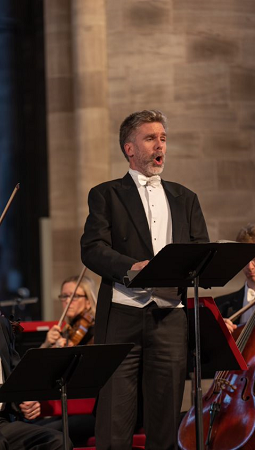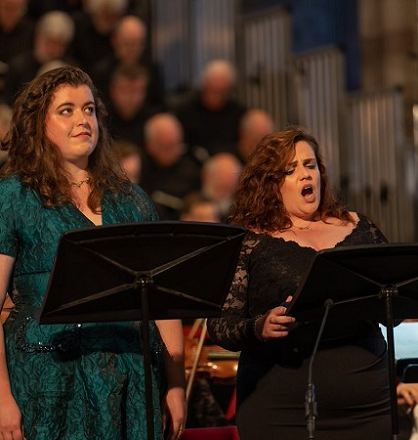George Dyson began composing his nine-movement ‘cycle of poems’, Quo Vadis, in 1936 and completed it as the Second World War was ending, in 1945, but if it the grand oratorio-like work is a musico-philosophical response to the violence of the era, then it is Dyson’s own experiences in the trenches during WW1 that most likely inform its contemplative consideration of man’s place in the eternal cycle, the music communicating Dyson’s reflections about the nature of life and the afterlife.
Dyson (1883-1964) came from a working-class background. Recognising his musical bent, his family encouraged him to play the organ in his local church and at the age of sixteen he won a scholarship to the Royal College of Music, where he studied composition with Charles Stanford. Winning the Mendelssohn Scholarship in 1904 enabled him to travel to Europe but his musical studies and early teaching career were interrupted by the outbreak of war in 1914. He fought on the Western Front (his Manual of Grenade Fighting became a standard Army text); when he was invalided out, his former tutor, Hubert Parry, described him as a shadow of his former self. After posts at Wellington College and Winchester College, Dyson was appointed Director of the RCM in 1938, the first former student to assume the position, and remained there until 1952.

The first part of Quo Vadis was prepared for the 1939 Three Choirs Festival, but its first performance was cancelled because of the outbreak of war. It was first performed in April 1945 at the Royal Albert Hall and repeated at Hereford Cathedral during the 1946 Three Choirs, conducted by the composer, and at Gloucester the following year. The complete work had its first performance at Hereford on 8th September 1949. Performances since have been rare, however; even before his death in 1962, Dyson’s music – unashamedly tonal and situated firmly within the English choral tradition of Stanford, Parry, Howells and Vaughan Williams – was considered conservative, labelled out of date and neglected.
The return of Quo Vadis to Hereford Cathedral during this year’s Three Choirs Festival, with Adrian Partington conducting the Three Choirs Festival Chorus and Philharmonia Orchestra, was thus a welcome home-coming and opportunity to experience Dyson’s visionary work – described by the late Christopher Palmer as a representation of ‘man’s earthly pilgrimage, his spiritual odyssey and its consummation in Shelley’s “white radiance of Eternity”’ – within the embracing acoustic of the cathedral for which it was designed.

Quo Vadis – literally, ‘where are you going?’ – is not a specifically Christian work, although at times it draws on biblical texts and well-known hymns such as ‘God be in my head’ and ‘New every morning’. The agnostic Dyson fashioned his own text from a wide array of sources, selecting passages from poets including Raleigh, Campion, Heywood, Herbert, Traherne, Vaughan, Herrick, Shelley, Keble, Newman and Bridges, ‘mixing and matching’ various lines within movements to form an elaborate tapestry. Only the first movement presents text by a single poet, but even here Dyson selects and rearranges lines from Wordsworth’s Intimations of Immortality. He also includes such well-known hymns as God be in my head and New every morning without hinting at the respective hymn-tunes.
The scoring for full orchestra, four soloists – here, soprano Rebecca Hardwick, contralto Jess Dandy, tenor James Oxley and baritone Alex Ashworth – full and semi-chorus reflects Dyson’s visionary ambition, scale and design, but Quo Vadis is not bombastic, more notable for its extended lyrical flow and gentle but penetrating reflections within which urgent climaxes build and ebb back into the prevailing quiet ecstasy. Partington’s achievement in balancing the various forces and sustaining the choral continuity of the work, while drawing highly coloured playing from the Philharmonia and directly communicative singing from the soloists was considerable. The broad sweep was powerful and noble, but there was also tenderness and intimacy, as well as darkness and mystery, such contrasting feelings bound persuasively within the whole.

Partington discerningly structured the large, complex choral passages. The smoothly unfolding first movement, ‘Our birth is but a sleep’, grew from the soft intimations of the ‘angelic’ female chorus, through an episode for men’s voices which was darkened by the richness of the double basses, to the effulgent warmth of the “mighty waters rolling evermore”, the voices held aloft by surging string arpeggios. The structure of the fifth movement, ‘O timely happy, timely wise’, is intricate, interlacing instrumental soli – some terrifically gutsy G-string violins at the start over an Elgarian bass line – acapella semi-choral passages, soprano solos, ensembles for the solo quartet and big choral upwellings. Partington’s one-in-a-bar pulse created a pressing momentum, pushing forward the brass and timpani towards the central climax, a spacious, resounding choral jubilation: “With its ten thousand tongues/ The everlasting sea proclaims/ Echoing angelic song.” And, after the glory, the calm: the chasteness of the distanced medieval chant, ‘Vexilla regis pradeunt’, the transcendence of the semi-chorus above a pedal bass, the extended peacefulness of the closing, fading ‘Amen’.
The lower strings’ martial step at the start of the seventh movement, ‘Come to me, God’, was envigoured by brass snarls, then quelled by the thoughtful lyricism of Alex Ashworth’s baritone solo and the strange, unexpected harmonic twists and turns. There was a sense of the pilgrim searching, finding his way, becoming more certain through the hymn-like episode, his growing confidence represented by the contrapuntal vigour of the choral canon, “My soul, there is a country”. Dyson largely eschews ‘theatre’, but Ashworth’s pronouncement, “He is thy gracious friend” who “Did in pure love descend/ To die here for thy sake”, above the massed choral voices, was thrilling.

Jess Dandy’s contralto solo, initially unaccompanied, at the opening of the second movement, ‘Rise, O my soul’, had a wonderful gravity and focus – it was good to have the genuine ‘weight’ of a contralto voice in the imploration, “So live thy better, let they worse thoughts die”. The moment had a lovely intimacy, accompanied as it was by solo violin and cello and chamber-like woodwind. There was a similar calm and focus in the penultimate setting, of Newman’s ‘They are at rest’, Dandy initially accompanied by light strings gently coloured by the woodwind, then joined by the solo quartet whose lines flourished into extended ‘Alleluias’, creating exciting patterns and blocks of harmony.
In ‘O wither hall my troubled muse incline’, Ashworth revealed the strength underpinning his lyrical baritone. His tone was clear and open as Partington drove the music forward in heroic fashion, the brass blazing, the vivid choral lines shining gloriously. The closing major key cadence emotively dramatised the triumph of the close, as the Lord descends, regally, “on the wings of might winds”. Rebecca Hardwick had to wait a while for her moment, but proved a fine soprano soloist in the sixth movement, ‘Dear stream! Dear bank!’, accompanied by vigorous string playing and long-breathed woodwind. Her soaring solo, taken from ‘The Waterfall’ by Henry Vaughan’, was bright and firm, the radiance of the tone imbuing Vaughan’s reflections on the passing of time with a focused passion. Solo violin and oboe beautifully complemented the setting of George Herbert’s paraphrase of Psalm 23 which follows.

A particular highlight was tenor James Oxley’s haunting cry for comfort and peace in the fourth movement, ‘Night hath no wings’, in which he conversed with a wonderfully tender viola prayer, the quiet intensity of the vocal line – “In the hour of my distress … When the house doth sigh and weep” – complemented by the slowly unfolding counterpoint, expressive harmonies and tender textures in the strings. The melismatic plea, “Sweet spirit, comfort me”, was deeply moving.
The passionate exultation of the concluding movement, ‘To find the western path’, began slowly – stirring brass above a low pedal and a declamatory tenor solo – then grew inexorably through accelerating, agitated episodes, and muscular choral passages, gathering conviction and culminating in a blazing, brassy expression of faith and spiritual triumph: “This is alone Life, Joy, Empire and Victory.” Quo Vadis ends, though, not with passion but with introspection, with the solo quartet of voices quietly asserting, “Holy is the true light”. These closing lines – positive, reassuring – were delivered with a quiet directness, without rhetoric, the music fading into silence, the vision confirmed but ever elusive – eternal peace not so much achieved as believed.
Claire Seymour
George Dyson: Quo Vadis
Rebecca Hardwick (soprano), Jess Dandy (contralto), James Oxley (tenor), Alex Ashworth (baritone), Adrian Partington (conductor), Three Choirs Festival Chorus, Philharmonia Orchestra
Hereford Cathedral, Hereford; Tuesday 25th July 2022.
ABOVE: Adrian Partington (conductor) conducts Dyson’s Quo Vadis at the Three Choirs Festival, Hereford (c) Dale Hodgetts & James O’Driscoll